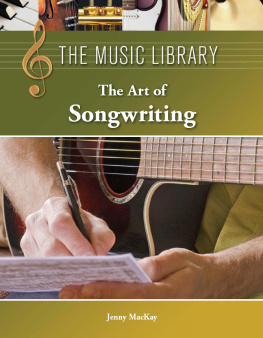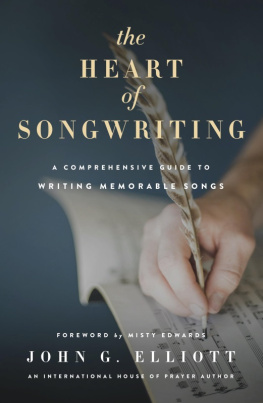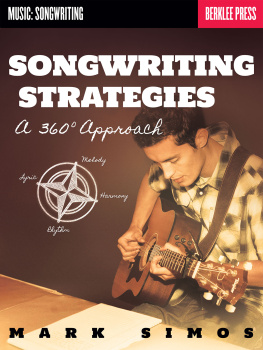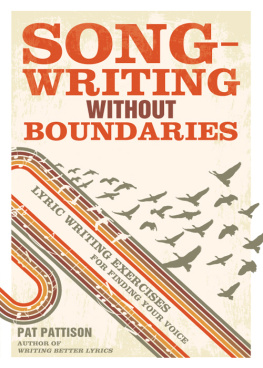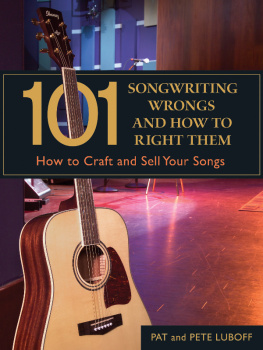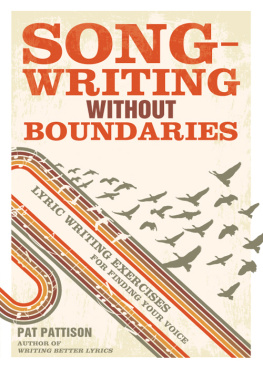THE MUSIC LIBRARY
The Art of Songwriting
TITLES IN THIS SERIES INCLUDE:
The History of Alternative Rock
The History of American Pop
The History of the Blues
The History of Classical Music
The History of Country Music
The History of Gospel Music
The History of Jazz
The History of Latin Music
The History of Music Videos
The History of R&B and Soul
The History of Rap and Hip-Hop
The History of Rock and Roll
The Instruments of Music
2014 Gale, Cengage Learning
ALL RIGHTS RESERVED. No part of this work covered by the copyright herein may be reproduced, transmitted, stored, or used in any form or by any means graphic, electronic, or mechanical, including but not limited to photocopying, recording, scanning, digitizing, taping, Web distribution, information networks, or information storage retrieval systems, except as permitted under Section 107 or 108 of the 1976 United States Copyright Act, without the prior written permission of the publisher.
Every effort has been made to trace the owners of copyrighted material.
LIBRARY OF CONGRESS CATALOGING-IN-PUBLICATION DATA
MacKay, Jenny, 1978
The art of songwriting / by Jenny MacKay.
pages cm. -- (The music library)
Includes bibliographical references and index.
ISBN 978-1-4205-0943-4 (hardcover)
1. Popular music--Writing and publishing--Juvenile literature. I. Title.
MT67.M15 2014
782.4213--dc23 2013022287
Lucent Books 27500
Drake Rd Farmington
Hills MI 48331
ISBN-13: 978-1-4205-0943-4
ISBN-10: 1-4205-0943-8
CONTENTS
Foreword
Introduction
The Culture of Writing in Song
Chapter 1
The History of American Pop Music
Chapter 2
Melody, Harmony, and Rhythm
Chapter 3
All in the Words
Chapter 4
Putting the Pieces of a Song Together
Chapter 5
The Business of Songwriting
Notes
Recommended Listening
Glossary
For More Information
Index
Picture Credits
About the Author
FOREWORD
I n the nineteenth century, English novelist Charles Kingsley wrote, Music speaks straight to our hearts and spirits, to the very core and root of our souls.... Music soothes us, stirs us up... melts us to tears. As Kingsley stated, music is much more than just a pleasant arrangement of sounds. It is the resonance of emotion, a joyful noise, a human endeavor that can soothe the spirit or excite the soul. Musicians can also imitate the expressive palette of the earth, from the violent fury of a hurricane to the gentle flow of a babbling brook.
The word music is derived from the fabled Greek muses, the children of Apollo who ruled the realms of inspiration and imagination. Composers have long called upon the muses for help and insight. Music is not merely the result of emotions and pleasurable sensations, however.
Music is a discipline subject to formal study and analysis. It involves the juxtaposition of creative elements such as rhythm, melody, and harmony with intellectual aspects of composition, theory, and instrumentation. Like painters mixing red, blue, and yellow into thousands of colors, musicians blend these various elements to create classical symphonies, jazz improvisations, country ballads, and rock-and-roll tunes.
Throughout centuries of musical history, individual musical elements have been blended and modified in infinite ways. The resulting sounds may convey a whole range of moods, emotions, reactions, and messages. Music, then, is both an expression and reflection of human experience and emotion.
The foundations of modern musical styles were laid down by the first ancient musicians who used wood, rocks, animal skinsand their own bodiesto re-create the sounds of the natural world in which they lived. With their hands, their feet, and their very breath they ignited the passions of listeners and moved them to their feet. The dancing, in turn, had a mesmerizing and hypnotic effect that allowed people to transcend their worldly concerns. Through music they could achieve a level of shared experience that could not be found in other forms of communication. For this reason, music has always been part of religious endeavors, from ancient Egyptian spiritual ceremonies to modern Christian masses. And it has inspired dance movements from kings and queens spinning the minuet to punk rockers slamming together in a mosh pit.
By examining musical genres ranging from Western classical music to rock and roll, readers will find a new understanding of old music and develop an appreciation for new sounds. Books in Lucents Music Library focus on the music, the musicians, the instruments, and on musics place in cultural history. The songs and artists examined may be easily found in the CD and sheet music collections of local libraries so that readers may study and enjoy the music covered in the books. Informative sidebars, annotated bibliographies, and complete indexes highlight the text in each volume and provide young readers with many opportunities for further discussion and research.
INTRODUCTION
The Culture of Writing in Song
M usic and songs have been a central part of human history and culture for thousands of years. Songs help people form communities, understand and describe the world they live in, share their joys and victories, and lament about hard times. Music defines groups, cultures, and even nations, as people use songs to describe themselves, who they are, and what has mattered to them in their lives.
Because it mirrors human experience and development, music changes over time. Some songs and tunes remain popular from one generation to the next, but each generation develops its own musical style that reflects its struggles, accomplishments, and emotions. New songs are written and sung to keep up with social changes; hit songs change as rapidly as any of societys fads. The people who write music strive to create the next popular ditty, even though it may enjoy only fleeting success. Modern songwriters require perseverance, originality, and above all, knowledge of their audience to write songs that will become hits.
The Voices of Generations
Music has always served an important function in human culture. It unites people of a common culture by giving them a particular sound and style they can call their own. People working in mundane or unpleasant jobs over the millennia of human history have done so to song. Armies marching into battle, pirates on raiding ships, slave laborers, and countless others have sung their way through their tasks. Songs for such purposes have always had characteristic rhythms that helped people march or work in tandem. The rhythmic tradition of music is no less important in modern times. A catchy rhythm still makes people sit up and take notice. Modern music depends on rhythm to serve as a background for dancea practice no less common in modern times than it was in ancient cultures for whom dancing was a common recreational and often spiritual experience.
Music depends on melody as well: the rise and fall of notes and sounds in special (often rhythmic) patterns. Melodies guide musical development in ways rhythm alone cannot. They incite people to sing or hum along. Melodies work their way into listeners minds and give emotion to music. Classical composers, from the Middle Ages on, have told stories and sagas using melody and rhythm.
Next page
